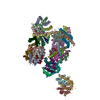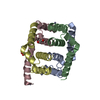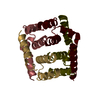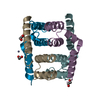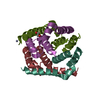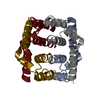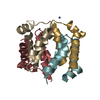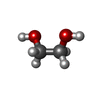[English] 日本語
 Yorodumi
Yorodumi- PDB-8spe: Crystal structure of Bax core domain BH3-groove dimer - tetrameri... -
+ Open data
Open data
- Basic information
Basic information
| Entry | Database: PDB / ID: 8spe | ||||||
|---|---|---|---|---|---|---|---|
| Title | Crystal structure of Bax core domain BH3-groove dimer - tetrameric fraction P31 | ||||||
 Components Components | Apoptosis regulator BAX | ||||||
 Keywords Keywords | APOPTOSIS / BAX / BCL2 | ||||||
| Function / homology |  Function and homology information Function and homology informationT cell homeostatic proliferation / release of matrix enzymes from mitochondria / positive regulation of developmental pigmentation / BAX complex / protein insertion into mitochondrial membrane / B cell receptor apoptotic signaling pathway / positive regulation of reproductive process / positive regulation of motor neuron apoptotic process / regulation of mammary gland epithelial cell proliferation / Activation, translocation and oligomerization of BAX ...T cell homeostatic proliferation / release of matrix enzymes from mitochondria / positive regulation of developmental pigmentation / BAX complex / protein insertion into mitochondrial membrane / B cell receptor apoptotic signaling pathway / positive regulation of reproductive process / positive regulation of motor neuron apoptotic process / regulation of mammary gland epithelial cell proliferation / Activation, translocation and oligomerization of BAX / spermatid differentiation / Sertoli cell proliferation / NTRK3 as a dependence receptor / positive regulation of apoptotic DNA fragmentation / development of secondary sexual characteristics / positive regulation of B cell apoptotic process / positive regulation of mitochondrial membrane permeability involved in apoptotic process / B cell homeostatic proliferation / glycosphingolipid metabolic process / retinal cell programmed cell death / B cell negative selection / BAK complex / regulation of mitochondrial membrane permeability involved in programmed necrotic cell death / negative regulation of endoplasmic reticulum calcium ion concentration / apoptotic process involved in embryonic digit morphogenesis / mitochondrial permeability transition pore complex / Release of apoptotic factors from the mitochondria / mitochondrial fragmentation involved in apoptotic process / apoptotic process involved in blood vessel morphogenesis / post-embryonic camera-type eye morphogenesis / Transcriptional regulation by RUNX2 / establishment or maintenance of transmembrane electrochemical gradient / apoptotic process involved in mammary gland involution / positive regulation of apoptotic process involved in mammary gland involution / regulation of nitrogen utilization / B cell apoptotic process / endoplasmic reticulum calcium ion homeostasis / positive regulation of epithelial cell apoptotic process / fertilization / calcium ion transport into cytosol / epithelial cell apoptotic process / mitochondrial fusion / Bcl-2 family protein complex / myeloid cell homeostasis / motor neuron apoptotic process / execution phase of apoptosis / thymocyte apoptotic process / hypothalamus development / pore complex / positive regulation of IRE1-mediated unfolded protein response / odontogenesis of dentin-containing tooth / positive regulation of release of cytochrome c from mitochondria / TP53 Regulates Transcription of Genes Involved in Cytochrome C Release / germ cell development / apoptotic mitochondrial changes / BH3 domain binding / vagina development / negative regulation of mitochondrial membrane potential / intrinsic apoptotic signaling pathway by p53 class mediator / B cell homeostasis / positive regulation of calcium ion transport into cytosol / negative regulation of apoptotic signaling pathway / intrinsic apoptotic signaling pathway in response to endoplasmic reticulum stress / extrinsic apoptotic signaling pathway via death domain receptors / blood vessel remodeling / cellular response to unfolded protein / Pyroptosis / ectopic germ cell programmed cell death / response to axon injury / negative regulation of fibroblast proliferation / negative regulation of protein binding / ovarian follicle development / positive regulation of intrinsic apoptotic signaling pathway / supramolecular fiber organization / extrinsic apoptotic signaling pathway / response to salt stress / release of sequestered calcium ion into cytosol / extrinsic apoptotic signaling pathway in absence of ligand / Hsp70 protein binding / homeostasis of number of cells within a tissue / intrinsic apoptotic signaling pathway / TP53 Regulates Transcription of Genes Involved in G2 Cell Cycle Arrest / release of cytochrome c from mitochondria / positive regulation of release of sequestered calcium ion into cytosol / response to gamma radiation / regulation of mitochondrial membrane potential / apoptotic signaling pathway / kidney development / positive regulation of protein-containing complex assembly / cerebral cortex development / cellular response to virus / response to toxic substance / neuron migration / intrinsic apoptotic signaling pathway in response to DNA damage / cellular response to UV / nuclear envelope / positive regulation of neuron apoptotic process / retina development in camera-type eye / channel activity / regulation of apoptotic process Similarity search - Function | ||||||
| Biological species |  Homo sapiens (human) Homo sapiens (human) | ||||||
| Method |  X-RAY DIFFRACTION / X-RAY DIFFRACTION /  SYNCHROTRON / SYNCHROTRON /  MOLECULAR REPLACEMENT / Resolution: 2.3 Å MOLECULAR REPLACEMENT / Resolution: 2.3 Å | ||||||
 Authors Authors | Miller, M.S. / Cowan, A.D. / Colman, P.M. / Czabotar, P.E. | ||||||
| Funding support |  Australia, 1items Australia, 1items
| ||||||
 Citation Citation |  Journal: Febs J. / Year: 2024 Journal: Febs J. / Year: 2024Title: Sequence differences between BAX and BAK core domains manifest as differences in their interactions with lipids. Authors: Miller, M.S. / Cowan, A.D. / Brouwer, J.M. / Smyth, S.T. / Peng, L. / Wardak, A.Z. / Uren, R.T. / Luo, C. / Roy, M.J. / Shah, S. / Tan, Z. / Reid, G.E. / Colman, P.M. / Czabotar, P.E. | ||||||
| History |
|
- Structure visualization
Structure visualization
| Structure viewer | Molecule:  Molmil Molmil Jmol/JSmol Jmol/JSmol |
|---|
- Downloads & links
Downloads & links
- Download
Download
| PDBx/mmCIF format |  8spe.cif.gz 8spe.cif.gz | 474.4 KB | Display |  PDBx/mmCIF format PDBx/mmCIF format |
|---|---|---|---|---|
| PDB format |  pdb8spe.ent.gz pdb8spe.ent.gz | 387.8 KB | Display |  PDB format PDB format |
| PDBx/mmJSON format |  8spe.json.gz 8spe.json.gz | Tree view |  PDBx/mmJSON format PDBx/mmJSON format | |
| Others |  Other downloads Other downloads |
-Validation report
| Summary document |  8spe_validation.pdf.gz 8spe_validation.pdf.gz | 717.8 KB | Display |  wwPDB validaton report wwPDB validaton report |
|---|---|---|---|---|
| Full document |  8spe_full_validation.pdf.gz 8spe_full_validation.pdf.gz | 739.4 KB | Display | |
| Data in XML |  8spe_validation.xml.gz 8spe_validation.xml.gz | 72 KB | Display | |
| Data in CIF |  8spe_validation.cif.gz 8spe_validation.cif.gz | 101.4 KB | Display | |
| Arichive directory |  https://data.pdbj.org/pub/pdb/validation_reports/sp/8spe https://data.pdbj.org/pub/pdb/validation_reports/sp/8spe ftp://data.pdbj.org/pub/pdb/validation_reports/sp/8spe ftp://data.pdbj.org/pub/pdb/validation_reports/sp/8spe | HTTPS FTP |
-Related structure data
| Related structure data |  8g1tC  8spfC  8spzC  8srxC  8sryC  8svkC C: citing same article ( |
|---|---|
| Similar structure data | Similarity search - Function & homology  F&H Search F&H Search |
- Links
Links
- Assembly
Assembly
- Components
Components
| #1: Protein | Mass: 8972.228 Da / Num. of mol.: 36 Source method: isolated from a genetically manipulated source Source: (gene. exp.)  Homo sapiens (human) / Gene: BAX, BCL2L4 / Production host: Homo sapiens (human) / Gene: BAX, BCL2L4 / Production host:  #2: Chemical | ChemComp-ZN / #3: Chemical | ChemComp-EDO / #4: Chemical | ChemComp-PEG / | #5: Water | ChemComp-HOH / | Has ligand of interest | N | |
|---|
-Experimental details
-Experiment
| Experiment | Method:  X-RAY DIFFRACTION / Number of used crystals: 1 X-RAY DIFFRACTION / Number of used crystals: 1 |
|---|
- Sample preparation
Sample preparation
| Crystal | Density Matthews: 1.97 Å3/Da / Density % sol: 37.49 % |
|---|---|
| Crystal grow | Temperature: 293 K / Method: vapor diffusion Details: 0.1 M NaMES pH 5.6, 27% PEG MME550, 0.01 M Zinc sulfate |
-Data collection
| Diffraction | Mean temperature: 100 K / Serial crystal experiment: N |
|---|---|
| Diffraction source | Source:  SYNCHROTRON / Site: SYNCHROTRON / Site:  Australian Synchrotron Australian Synchrotron  / Beamline: MX2 / Wavelength: 0.9537 Å / Beamline: MX2 / Wavelength: 0.9537 Å |
| Detector | Type: ADSC QUANTUM 315r / Detector: CCD / Date: Sep 25, 2015 |
| Radiation | Protocol: SINGLE WAVELENGTH / Monochromatic (M) / Laue (L): M / Scattering type: x-ray |
| Radiation wavelength | Wavelength: 0.9537 Å / Relative weight: 1 |
| Reflection | Resolution: 2.3→46.27 Å / Num. obs: 108680 / % possible obs: 99.8 % / Redundancy: 5.7 % / CC1/2: 0.998 / Rmerge(I) obs: 0.111 / Rpim(I) all: 0.051 / Rrim(I) all: 0.122 / Net I/σ(I): 10.9 |
| Reflection shell | Resolution: 2.3→2.34 Å / % possible obs: 96.3 % / Redundancy: 5.5 % / Rmerge(I) obs: 1.788 / Num. measured all: 28318 / Num. unique obs: 5174 / CC1/2: 0.464 / Rpim(I) all: 0.829 / Rrim(I) all: 1.973 / Net I/σ(I) obs: 1.1 |
- Processing
Processing
| Software |
| |||||||||||||||||||||||||||||||||||||||||||||||||||||||||||||||||||||||||||||||||||||||||||||||||||||||||
|---|---|---|---|---|---|---|---|---|---|---|---|---|---|---|---|---|---|---|---|---|---|---|---|---|---|---|---|---|---|---|---|---|---|---|---|---|---|---|---|---|---|---|---|---|---|---|---|---|---|---|---|---|---|---|---|---|---|---|---|---|---|---|---|---|---|---|---|---|---|---|---|---|---|---|---|---|---|---|---|---|---|---|---|---|---|---|---|---|---|---|---|---|---|---|---|---|---|---|---|---|---|---|---|---|---|---|
| Refinement | Method to determine structure:  MOLECULAR REPLACEMENT / Resolution: 2.3→35.43 Å / SU ML: 0.27 / Cross valid method: FREE R-VALUE / σ(F): 1.96 / Phase error: 33.03 / Stereochemistry target values: ML MOLECULAR REPLACEMENT / Resolution: 2.3→35.43 Å / SU ML: 0.27 / Cross valid method: FREE R-VALUE / σ(F): 1.96 / Phase error: 33.03 / Stereochemistry target values: ML
| |||||||||||||||||||||||||||||||||||||||||||||||||||||||||||||||||||||||||||||||||||||||||||||||||||||||||
| Solvent computation | Shrinkage radii: 0.9 Å / VDW probe radii: 1.1 Å / Solvent model: FLAT BULK SOLVENT MODEL | |||||||||||||||||||||||||||||||||||||||||||||||||||||||||||||||||||||||||||||||||||||||||||||||||||||||||
| Refinement step | Cycle: LAST / Resolution: 2.3→35.43 Å
| |||||||||||||||||||||||||||||||||||||||||||||||||||||||||||||||||||||||||||||||||||||||||||||||||||||||||
| Refine LS restraints |
| |||||||||||||||||||||||||||||||||||||||||||||||||||||||||||||||||||||||||||||||||||||||||||||||||||||||||
| LS refinement shell |
|
 Movie
Movie Controller
Controller


 PDBj
PDBj










